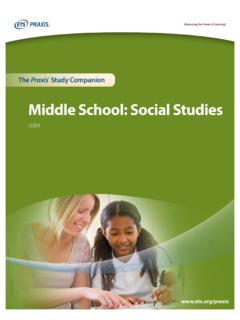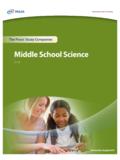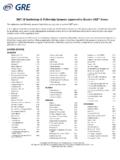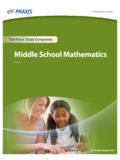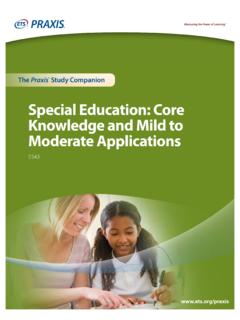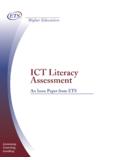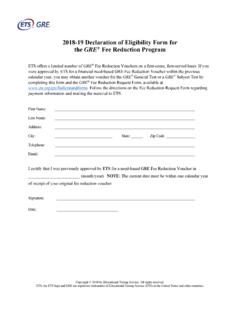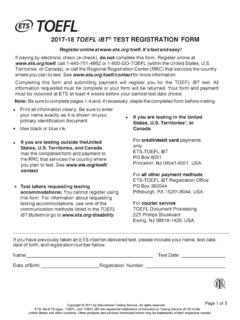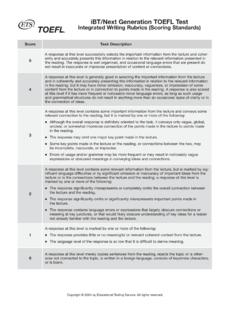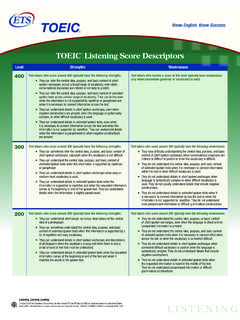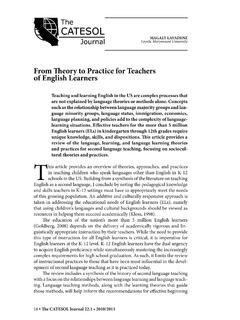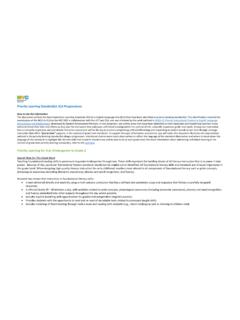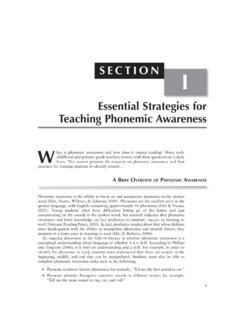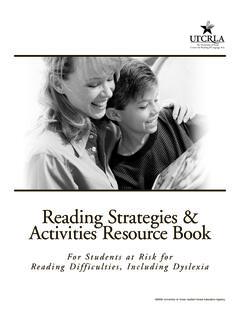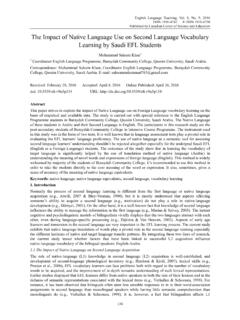Transcription of Teaching Reading: Elementary study companion
1 Teaching reading : Elementary Praxis study Companion2 The Praxis study CompanionWelcome to the Praxis study CompanionWelcome to the Praxis study companion Prepare to Show What You KnowYou have been working to acquire the knowledge and skills you need for your Teaching career. Now you are ready to demonstrate your abilities by taking a Praxis test. Using the Praxis study companion is a smart way to prepare for the test so you can do your best on test day. This guide can help keep you on track and make the most efficient use of your study study companion contains practical information and helpful tools, including: An overview of the Praxis tests Specific information on the Praxis test you are taking A template study plan study topics Practice questions and explanations of correct answers Test-taking tips and strategies Frequently asked questions Links to more detailed informationSo where should you start?
2 Begin by reviewing this guide in its entirety and note those sections that you need to revisit. Then you can create your own personalized study plan and schedule based on your individual needs and how much time you have before test in mind that study habits are individual. There are many different ways to successfully prepare for your test. Some people study better on their own, while others prefer a group dynamic. You may have more energy early in the day, but another test taker may concentrate better in the evening. So use this guide to develop the approach that works best for Teaching career begins with preparation. Good luck!Know What to ExpectWhich tests should I take? Each state or agency that uses the Praxis tests sets its own requirements for which test or tests you must take for the Teaching area you wish to you register for a test, confirm your state or agency s testing requirements at are the Praxis tests given?Praxis tests are given on computer.
3 Other formats are available for test takers approved for accommodations (see page 39).3 The Praxis study CompanionWelcome to the Praxis study CompanionWhat should I expect when taking the test on computer?When taking the test on computer, you can expect to be asked to provide proper identification at the test center. Once admitted, you will be given the opportunity to learn how the computer interface works (how to answer questions, how to skip questions, how to go back to questions you skipped, etc.) before the testing time begins. Watch the What to Expect on Test Day video to see what the experience is and when are the Praxis tests offered?You can select the test center that is most convenient for you. The Praxis tests are administered through an international network of test centers, which includes Prometric Testing Centers, some universities, and other locations throughout the schedules may differ, so see the Praxis web site for more detailed test registration information at The Praxis study Companion4 Table of ContentsTable of ContentsThe Praxis study companion guides you through the steps to success1.
4 Learn About Your Test ..5 Learn about the specific test you will be taking2. Familiarize Yourself with Test Questions ..9 Become comfortable with the types of questions you ll find on the Praxis tests3. Practice with Sample Test Questions ..13 Answer practice questions and find explanations for correct answers4. Determine Your Strategy for Success ..26 Set clear goals and deadlines so your test preparation is focused and efficient5. Develop Your study Plan ..29 Develop a personalized study plan and schedule6. Review study Topics ..33 Detailed study topics with questions for discussion7. Review Smart Tips for Success ..37 Follow test-taking tips developed by experts8. Check on Testing Accommodations ..39 See if you qualify for accommodations to take the Praxis test9. Do Your Best on Test Day ..40 Get ready for test day so you will be calm and confident10. Understand Your Scores ..42 Understand how tests are scored and how to interpret your test scoresAppendix: Other Questions You May Have.
5 44 The Praxis study Companion5 Step 1: Learn About Your Test1. Learn About Your TestLearn about the specific test you will be takingTeaching reading : Elementary (5205)Test at a GlanceTest Name Teaching reading : ElementaryTest Code 5205 Time 150 minutesNumber of Questions 90 selected response; 3 constructed responseFormat Selected-response and constructed-response questions. This test may include questions with an audio or video Delivery Computer delivered Approximate Approximate Content Categories Number of Percentage of Questions Examination I. phonological and Phonemic 13 11% Awareness including Emergent Literacy II. Phonics and Decoding 18 15% III. Vocabulary and Fluency 21 18% IV. Comprehension of Literary and 22 18% Informational Text V. Writing 15 13% VI.
6 Assessment and Instructional 3 25% Decision Making (Constructed Response) VIVIVIIIIIIA bout This TestThe Praxis Teaching reading : Elementary test focuses on the knowledge and skills a beginning teacher must have to support reading and writing development in kindergarten through sixth-grade students. Built to assess the science of reading , the test is structured around the five essential components of effective reading instruction as identified by the National reading Panel: phonemic awareness, phonics, vocabulary, fluency, and comprehension. The test also assesses the relationship between reading skills and writing instruction, since receptive and productive literacy are interrelated. Questions about assessment will be included throughout. The test as a whole acknowledges multiple approaches to pedagogy used in tandem with content. This includes but is not limited to integrating skills and embedding student instruction within context, as well as looking at concepts in isolation in order to build upon questions call on the individual s knowledge of research-based reading instruction and the science of Teaching reading , covering language, foundational skills and comprehension.
7 Test takers must be able to apply that knowledge to specific instructional scenarios, including showing an understanding of how to differentiate instruction for diverse students. The test taker will be required to analyze and respond to situations involving The Praxis study Companion6 Step 1: Learn About Your Testboth entire classes and individual students at grade levels from kindergarten through grade six, including English-language learners and students with diverse needs and backgrounds. The test includes texts from a wide range of genres and requires the candidate to be familiar with strategies for handling multiple text types with students, including print, digital, and image-based prompts. In addition to selected-response questions, the test contains three constructed-response questions designed to allow the test taker to show understanding in the areas of early literacy, developing reading instruction, and written expression. These questions are intended to be authentic Teaching tasks that require instructional decision making about such things as choosing instructional strategies and materials based on assessment information.
8 This test may contain some questions that will not count toward your SpecificationsTest specifications in this chapter describe the knowledge and skills measured by the test. study topics to help you prepare to answer test questions can be found on page phonological and Phonemic Awareness including Emergent LiteracyA. Understands instructional methods for Teaching phonological awareness (recognition of rhyme and alliteration; segmenting, blending, manipulation of syllables as well as onset and rime)B. Understands instructional methods for Teaching phonemic awareness, both basic ( , segmenting and blending) and advanced ( , deletion, substitution)C. Knows ways to develop students expressive and receptive language skillsD. Knows instructional methods to teach beginning readers the concepts about print such as directionality, return sweep, parts of a book, and the form and function of printE. Understands instructional strategies to help emergent readers fluently identify upper- and lowercase letters in various fontsII.
9 Phonics and DecodingA. Understands how to teach phoneme-grapheme correspondenceB. Understands methods for Teaching phonics systematically, explicitly, and recursivelyC. Knows instructional methods for Teaching common phonics patterns and rules (consonant digraphs, blends, diphthongs, schwa sound, syllable types, word families, etc.)D. Knows how to teach morphological analysis ( , affixes, roots, and base words)E. Knows how to teach syllable types in decoding multisyllabic wordsF. Is familiar with multisensory approaches for supporting student recognition of nondecodable/irregularly spelled words ( , was, listen, though, the, once)III. Vocabulary and FluencyA. Understands ways to build, expand, and use expressive and receptive vocabularyB. Understands methods for Teaching vocabulary systematically, explicitly, and repeatedly in multiple contextsC. Knows how to match an instructional method to word complexityD. Knows multiple approaches to Teaching word solving, including the use of context clues and structural analysisE.
10 Knows how to guide students to understand a wide variety of words (common, contextual, content-specific) through direct instruction and independent vocabulary learningF. Understands instructional methods to foster students automaticity through accuracy , appropriate rate, and prosodyG. Knows methods of supporting fluent reading behaviors at the phoneme, word, and passage levelH. Knows how fluency, vocabulary, and comprehension are interrelatedThe Praxis study Companion7 Step 1: Learn About Your TestIV. Comprehension of Literary and Informational TextA. Understands how to support students listening comprehension and its relationship to reading comprehensionB. Knows how to support students speaking and listening skills as they discuss textsC. Understands how to activate and build all students background knowledge to increase comprehensionD. Is familiar with methods for Teaching comprehension systematically and explicitly to all learnersE.
